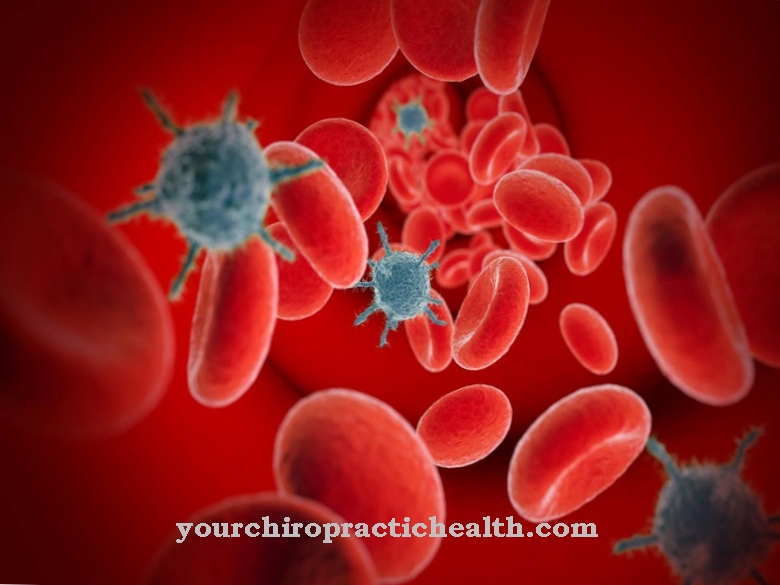A Cartilage damage is a joint disease that occurs in different joints in the body. Depending on how badly the respective cartilage is damaged and what type of cartilage it is, a painless restoration of the cartilage function can be achieved with a suitable therapy.
What is Cartilage Damage?

© motortion - stock.adobe.com
Under a Cartilage damage Doctors understand, as the name suggests, damage to the cartilage. The bones meet in the joints.
To prevent unpleasant friction from occurring, the ends of the bones are covered with what is known as cartilage tissue. This can cushion shocks when walking and thus protect the bones or the joint. If this layer is removed, for example due to illness or wear and tear, the smooth movement of the joint is restricted.
There is also pain, which only occurs when the cartilage tissue is completely destroyed. The knee and hip joints are particularly often affected. Recognized at an early stage, the cartilage can be regenerated through medical measures. Once the layer has been completely removed, it is no longer possible to restore it.
causes
The causes for one Cartilage damage can be diverse. Experts differentiate between mechanical and biochemical causes. The former can, for example, be the result of an accident or other injury.
A severe sprain can also lead to cartilage damage. Bad posture such as so-called bow-legs or knock-knees can cause the cartilage layer to be damaged due to the permanent incorrect loading. The same applies to being very overweight, which puts excessive strain on the joints when walking.
The biochemical causes of cartilage damage include metabolic diseases. Diseases such as gout, rheumatism or circulatory disorders can permanently damage the cartilage layer. Ultimately, age-related calcification can also cause the cartilage to gradually break down.
Symptoms, ailments & signs
Cartilage damage manifests itself primarily through pain when walking and when the affected joint is generally stressed. The pain can block the joint, which in turn results in restricted mobility. In individual cases there is swelling as a result of bleeding or fluid accumulation in the tissue.
In the beginning, the pain only occurs after the joint has been subjected to extensive stress. In particular, when running, climbing stairs and going for a walk, complaints occur that usually lead to a relieving posture. Many sufferers complain of pain, especially in the morning and after long periods of sitting. The so-called initial pain is accompanied by a noticeable crunching or cracking of the damaged joints.
A long-term misalignment can lead to joint wear, pressure points, nerve pain and other complaints. Some people affected are also sensitive to the weather. Untreated cartilage damage can lead to the development of chronic pain. This is usually accompanied by a strong feeling of discomfort.
Athletes in particular suffer from severe cartilage damage and feel restricted in their quality of life. In the long term, this can lead to the development of psychological complaints, such as depressive moods, irritability and changes in personality. If the cartilage damage is treated early, the symptoms usually subside after a few weeks.
Diagnosis & course
Is there any suspicion of one Cartilage damageThis is usually diagnosed by the attending physician using an X-ray examination. This can already provide information about a degenerative change in the cartilage tissue. An MRI, a magnetic resonance tomography, can also be used to help determine exactly to what extent the cartilage has already been damaged and what chances of recovery exist.
In principle, cartilage damage can be treated medically; however, it depends on the stage of the damage. If the disease is recognized early, the chances are good that the cartilage layer can regenerate almost completely. However, once they have been completely dismantled, there is no way to restore them.
Complications
In the case of cartilage damage, the further course of the disease in most cases depends very much on the affected region of the body, so that no general prediction is possible. Most patients suffer from severe joint pain due to the cartilage damage. This pain can significantly limit the patient's everyday life and reduce the quality of life.
Furthermore, there are also movement restrictions and general restrictions in everyday life. It is not uncommon for swelling or bruising to occur. If there is no treatment for cartilage damage, then in most cases osteoarthritis will develop. This can lead to irreversible consequential damage.
In most cases, cartilage damage is treated with medication. There are no further complications. In some cases, however, surgery is necessary to correct the symptoms. The patient may need to take antibiotics after the procedure to prevent inflammation.
In most cases, this disease will not reduce or limit life expectancy. After the treatment, the sufferer can usually use the joints normally again.
When should you go to the doctor?
People who experience joint pain following a sprain or related illness should see a doctor the same day. Symptoms such as restricted mobility, swelling, and bruising indicate cartilage damage. Medical advice is required if the symptoms do not subside by themselves or even get worse. If further symptoms arise, a doctor must be called in immediately. Cartilage damage can be treated well, but it also progresses rapidly and causes increasing pain.
Before irreversible consequential damage occurs, the injury must be clarified and treated. People who suffer from bow-legs or knock-knees are particularly at risk. Likewise people with overweight, a rheumatic illness, gout or circulatory disorders. If you are part of these risk groups, it is best to inform your doctor about the symptoms mentioned. At the latest, when painful swellings or restrictions in the mobility of the affected part of the body are noticed, a visit to the family doctor is indicated. Other contact points are the orthopedic surgeon or a specialist in joint and bone diseases.
Treatment & Therapy
Clearly became one Cartilage damage diagnosed, the attending physician will initiate appropriate therapy. This depends in particular on the severity of the damage and also on the position of the joint in the body. The conservative form of therapy usually includes drug treatment, which initially relieves existing pain.
At the same time, anti-inflammatory drugs are administered that eliminate or reduce any inflammatory processes in the joint. The administration of drugs, which are supposed to stimulate the metabolism in the cartilage, can help to increase the mobility of the joint. Here, for example, hyaluronic acid can be administered, which is also found in the natural synovial fluid. If the cartilage damage has progressed too far or if drug therapy does not work, surgery can be useful.
In this case, the cartilage can be surgically smoothed. This leads to any inflammation subsiding and to frictionless and largely painless movement of the joint. If the cartilage has not yet been damaged too much, only a thin layer can be removed, whereupon the cartilage tissue regenerates itself and the symptoms subside.
Outlook & forecast
The prognosis of cartilage damage depends on the affected joint and the possibility of therapy. In some cases, the functional activity of the joint and thus the cartilage function can be restored. The administration of medication rebuilds the cartilage. If movement sequences are optimized and adjusted at the same time, there is a prospect of complete freedom from symptoms.
The further a cartilage damage has progressed, the less likely a recovery is. Without changes in the movement sequences and physical stress or the use of medical care, the prognosis worsens. Pain, irregularities in the musculoskeletal system and restricted mobility increase. In some patients, surgery is the last option, as the administration of medication is not sufficient for advanced cartilage damage. The operation is associated with the usual risks and side effects and can lead to permanent deterioration in health. If an operation goes without further complications, the patient will experience an improvement in his health afterwards.
The relief of existing complaints is documented in most cases. Nevertheless, it may be necessary to restructure everyday processes, as the physical resilience does not correspond to that of a person with a natural physique. Sports or professional activities cannot always be continued as the patient did before the procedure.
prevention
One Cartilage damage can be prevented in several ways. The prevention or reduction of excess weight relieves the joints and prevents possible damage to the cartilage. Bad postures such as knock knees or bow legs should be corrected if possible so that there is no later cartilage damage. Cartilage damage caused by metabolic diseases or injuries cannot be prevented. If there is the first suspicion of a corresponding damage to the joints, it is advisable to consult a doctor (usually an orthopedist.
Aftercare
The cartilage damage requires consistent aftercare. Massively damaged cartilage is no longer reversible, but the respective joint can be stabilized in a targeted manner with targeted training of the surrounding muscles. Follow-up care usually takes place in consultation with the treating orthopedic surgeon or the physiotherapist. The specialized rehabilitation sport with trainers qualified for this clinical picture is also a professional address in this context.
Muscles that can stabilize a joint are specifically strengthened in the follow-up care. The patient often learns exercises in physiotherapy or rehabilitation, which they then carry out independently at home or in the gym. The correct execution of the exercises and an individually dosed load are particularly important here.
Follow-up care for cartilage damage is also an important topic in everyday life. The joint that is affected by the clinical picture must ideally no longer be subjected to unphysiological stress. This means that, for example, shear loads or excessive flexion are avoided in the knee joint. However, the joint does not generally need to be spared.
The joint fluid (synovia), which is formed when you move, protects the joint. A sufficient amount of drinking can also have a positive influence here. Long persistence in unhealthy postures should also be replaced by regular exercise.
You can do that yourself
If the cartilage is damaged, there are many ways to slow the progression of the disease. Self-help measures cannot entirely avoid an operation, but they can often postpone it for many years.
Sufficient exercise is particularly important - preferably in the form of joint-friendly sports such as swimming, cycling or Nordic walking. The patient decides which sport is most likely to be considered in consultation with the attending physician. Those who do not want to do active sport should at least integrate more exercise into everyday life. Just doing without elevators and escalators has a positive effect on overall health and can delay the further spread of cartilage damage.
In order to reduce the stress on the joints, it is also advisable to avoid or reduce excess weight. Here, too, exercise is of great importance, as is a healthy, balanced and low-fat diet. For acute pain, pain ointments containing cortisone-free anti-inflammatory drugs (ketoprofen, indomethacin) have proven particularly effective, but warming ointments with the active ingredients nicoboxil and nonivamid are also found beneficial by many people affected.
If there is an acute joint inflammation, however, cooling compresses and ointments are especially recommended. Herbal medicines containing frankincense or devil's claw can also be used to accompany therapy.





.jpg)











.jpg)







.jpg)


